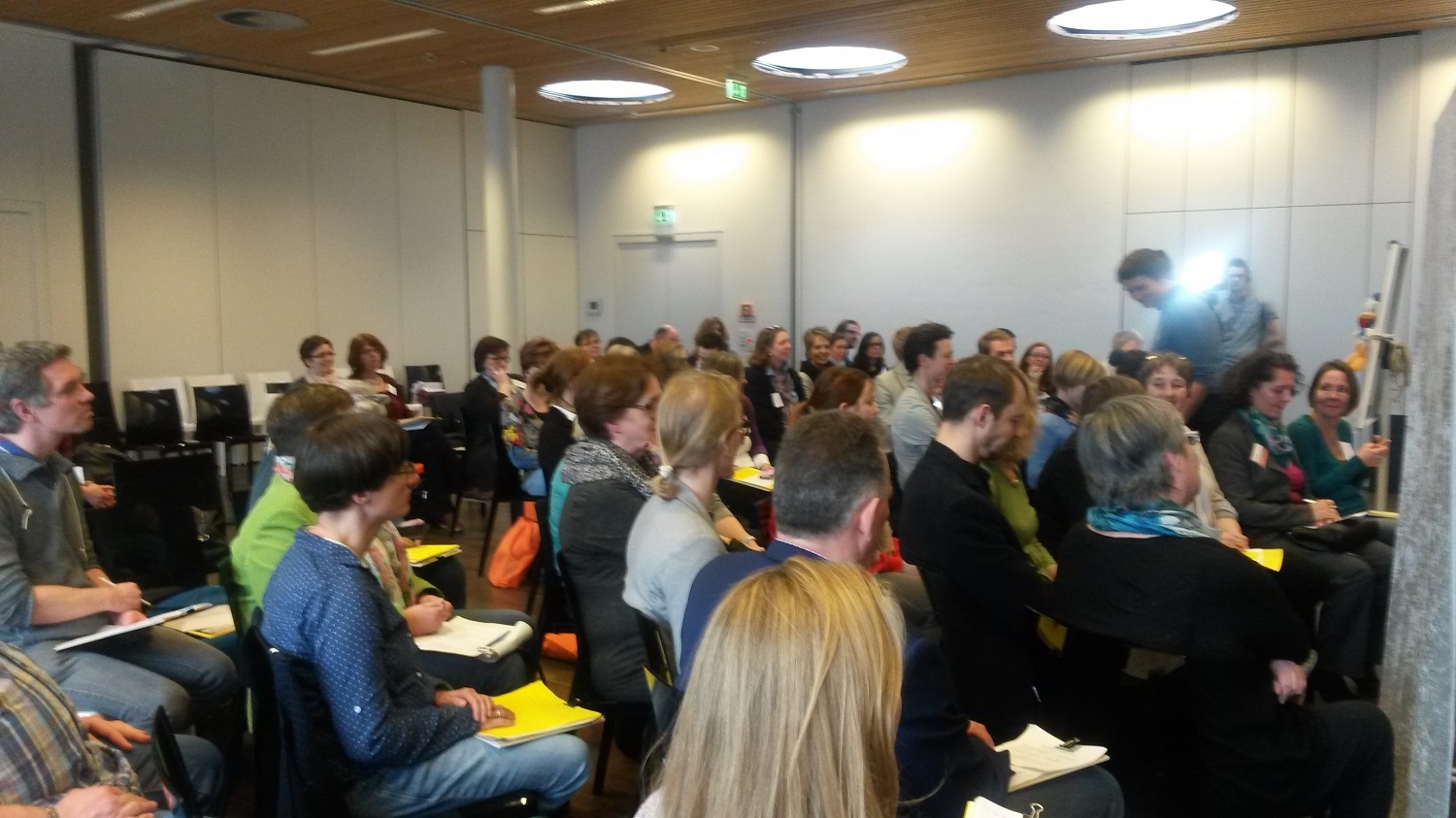s
s
s
Inspiring and Affirmative Trainer Congress in Berlin 2017
In this article, you can read about impressions and useful tips and tricks for you from the Trainer Congress in Berlin 2017 . Two trainers, Melanie Büscher from Copenhagen and I, both NCP-Academy trainers, are presenting a quick report about the following congress sessions:
- Inner freedom – accepting rather unwanted behaviours (link)
- I’m done with this! Repositioning for “old hands“ (link)
- Professional videos via smartphone – for trainers (link)
- PowerPoint alternatives – Imparting content in a memorable way (link)
- Disturbances you wish you never had – How to deal with difficult participants (link)
- Creative methods for group work and distribution – Lively and fun presentations by creative and effective teamwork (link)
- Top Ten – my favourite games from 20 years of training – Effective gimmicks for trainings of all kind (link)
First, I would like to mention that on March 18, 2017, I’ve attended the Trainer Congress in Berlin for the 6th time, which makes me somewhat a repeater, so to speak. Of course, there’s a reason for me to return to this congress every year, because I always get inspired and find acknowledgement for all the activities I’ve done. And that’s why I also signed up for the next one in 2018 (March 23rd and 24th).
I would like to address some points of interest I noted from the four sessions I have visited.
1. Inner freedom – accepting rather unwanted behaviours by Ulrike Scheuermann
“People condemn themselves for not being happy all the time,” says Ulrike. But even our rather unwanted behaviours are part of our life, if we like it or not. Good and bad always belongs together. And our sense of self-awareness is often connected with external factors hanging by a thin thread, even if the principle should be “I am valuable because I exist.”
Not only did we receive some theoretical input by Ulrike during this session, but we also conducted a short “logosynthesis” exercise with an up-to-date individual “challenge”.

2. I’m done with this! Repositioning for “old hands” by Katrin Fehlau
By now, I also consider myself as an old hand with years of training and moderation experience, which is why I chose to attend this session with about 15 other trainers. With joy and relief I then went out, simply because I had a chance to get aware of the fact that I have done my homework during the last years, especially in strategic terms. Furthermore, I don’t have to struggle with certain challenges like many others, who have been in business for a long time as well. And that’s not all! I still do my job with a lot of joy and enthusiasm and I see it more as a vocation than an actual job.
I positioned myself as an expert for moderation und training and developed my USP according to my biography, my values and my enthusiasm for topics like learning, moderating, and groups.
Last year, I had lots of extensive conversations with my clients, which were kind enough to spare some time and share some valuable insights with me. I then incorporated this new knowledge into my training design, new products (e.g. Live Online Trainings ) and also marketing activities.
3. Professional videos via smartphone – for trainers by Michael Witzke & Konstantin Ristl
This session was full of handy and immediately realisable tips enabling me to finally shoot some short videos myself. This was something I was looking forward to do since a while already, e.g. for a better visualisation of methods, or to improve the training transfer even further.
And here are the tips. The most important thing to remember; each video shouldn’t be longer than two minutes! Because after that, the attention of the viewer decreases or they just turn it off completely, as statistics confirm.
- “It’s not what you say, but how you say it“ – speak into a clip-on microphone for a clear and understandable voice!
- Optimal light, which illuminates especially your face. You can achieve this by using LED-Spots or simple photo lamps, ideally two of them; shining slightly from the top and from the side.
- Always use a landscape format and keep a steady image. This works best with a tripod and a monopod you can attach the phone to.
- Speak to each person individually, since people are most likely to watch the video by themselves and not in a group.
- Vary the scenario and follow the so-called Rule of Thirds, which means that you have to position yourself in the right third of the frame, leaving some space above your head. It’s enough to show your upper body during the recording. That way you can position a flip chart or add some text right next to you with a video editing software.
So, what are my next steps: I get the equipment, which costs about € 250 (without the smartphone) and then I will start with some self-experiments. I had one first attempt already, but with the help of my client Manfred Stadler from the company “Innovation Coaches”, who told about his experiences with BusinessMind workshop and training courses. But admittedly, we could only do a half-professional video, but that was clearly not his fault :-).
Another very exciting thing was the software blink.it for additional transfers during the training. I’ll take a closer look at it during the next weeks, and maybe I’ll even buy it, so I can accompany you even better before and after the training sessions.
4. PowerPoint Alternatives – Imparting content in a memorable way by Barbara Messer
All methods presented by Barbara Messer were definitely very memorable. One of them, a really extraordinary one – namely “window cleaner” – is the one you see on the following photo:

The posters with some of the presented methods were attached to the windows from the outside. Well, this requires some effort and it shouldn’t be raining, of course.
I also liked the “museum island“, where objects related to the respective training subject are placed on a table and then discussed (see picture above and the following chicken).

Posters were hung on a clothesline or individually. With a performance, they were then carried to a board and pinned there (instead using PowerPoint and a beamer).

She called this method the “PowerPoint Persiflage“. So, if I know one thing, then its that her messages were delivered and memorized a lot better with these diverse methods than any PowerPoint battle. If you want to delve into these remarkable methods, then take look at Barbara’s book (in German language), or at my book (the English version will be available mid 2017)!
And now it’s time for Melanie Büscher to speak up, a trainer, who’s been at the trainer congress in Berlin for the first time.
5. Disturbances you wish you never had – How to deal with difficult participants by Michael Rossié
“This is bullshit!” Sometimes, and especially if the participants are not voluntarily attending the seminar, thus not seeing the purpose and the applicability for their area right away, you as a trainer can really be confronted with resistance from time to time. It doesn’t happen very often, but it’s really stressful for both the participants and the trainers.
Michael showed clearly and convincingly, how important it is not to ignore any disturbances as a trainer, but to address them concretely. Not on the factual level, but emotional level, however. In the rarest cases, it’s not just all about the content or the trainer (as a trainer, you always have to be well prepared and professional, so you don’t talk trash) but other factors. Perhaps it requires a bit of courage to address certain underlying feelings. Trainers and participants usually don’t know each other personally, after all. But just like Michael said, the recognition of emotions in 9 out of 10 cases means that irritated participants feel taken seriously to contribute constructively once more.
And maybe you can even use this tip for your own relationship when it’s about minor things like the used coffee cup wasn’t put into the dishwasher again…
6. Creative methods for group work and distribution – Lively and fun presentations by creative and effective teamwork by Zamyat M. Klein
When preparing my own trainings, I always make sure that every single method I present has a clear meaning and purpose – and that’s why I am always a little skeptical about particularly creative and colourful ones. “The methods follow the goals“, as Birgit said and showed repeatedly.

When it comes to creative methods and the participants have to use movements, sounds and surprise effects, the trainer has to know even better about what exactly to support and to achieve. But for that, the groups who have to creatively prepare and present seminar topics must have recognized and understood the essence of the subject. Otherwise, they can’t represent the topic as a rap song, a sketch, a human machine, a flipchart without (almost) any text, etc. And that’s why the group has to intensively work, discuss and learn during the preparation phase. The resulting presentation will then be more fun and gives the participants lots of energy. That might be a nice way to end a seminar, for example.
7. Top Ten – my favourite games from 20 years of training – Effective “gimmicks” for trainings of all kind by Axel Rachow
As mentioned before, I don’t necessarily like “games” in trainings. Activities must provide a real added value for the participants and are not meant for entertainment. Axel, the trainer of this seminar, agrees with me. I was particularly fascinated by his continuous focus on metaphorical language and imagery. For example, he showed us his toolbox, which contains numerous small objects. He likes to make use of it at the beginning of a seminar, so his participants can choose their own objects from the box, which have a symbolic meaning according to the seminar’s topic for them – e.g. the mobile phone is a symbol for (a lack of) communication within the team, or the toy dinosaur acts as a symbol for the outdated production processes within the company.
Axel always brings the same suitcase – but his participants always give the objects very different meanings. But at the very beginning of each seminar its already clear that this simple exercise shows the participants – and us as trainers – during the discussion of the seminar’s topic, what the biggest challenges and the different possibilities are.

And that’s all from Melanie. Thanks for your contribution!
The memorable and incredibly funny ending was – just like many times before – arranged by the Impro-Theater frei.wild. Simply amazing!
So, that’s all about this year’s trainer congress in Berlin. If you’re curious to know more about last year’s, then you can read (but just in German) about 2016 here, and about 2015 here (this one was written by my colleague Nicole Schmidt) as well as 2014.
In case you visited the congress yourself, feel free to leave your own impressions! If not, I hope to see you there in 2018!
Warmly, Birgit Baumann






Leave A Comment